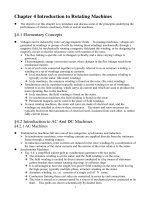ch04 100129134145 phpapp02
Bạn đang xem bản rút gọn của tài liệu. Xem và tải ngay bản đầy đủ của tài liệu tại đây (1.76 MB, 51 trang )
Chapter 4
Network Vulnerabilities and Attacks
Cyberwar and Cyberterrorism
"Titan Rain" - Attacks on US gov't and military
computers from China breached hundreds of
systems in 2005 (link Ch 4a)
In 2007, Estonia was attacked by Russian
computers as a political statement
Using DDoS (Distributed Denial of Service) with
botnets (Ch 4b)
Objectives
Explain the types of network vulnerabilities
List categories of network attacks
Define different methods of network attacks
Media-Based Vulnerabilities
Monitoring network traffic
Helps to identify and troubleshoot network
problems
Monitoring traffic can be done in two ways
Use a switch with port mirroring
Copies all traffic to a designated monitoring port on
the switch
Install a network tap (test access point)
A device that installed between two network devices,
such as a switch, router, or firewall, to monitor traffic
Port Mirroring
Sniffer
Network Tap
Sniffing Attacks
Just as network taps and protocol analyzers
can be used for legitimate purposes
They also can be used by attackers to intercept
and view network traffic
Attackers can access the wired network in the
following ways:
False ceilings
Exposed wiring
Unprotected RJ-45 jacks
Ways to Redirect Switched Traffic
Network Device Vulnerabilities
Passwords
Passwords should be long and complex
Should be changed frequently
Should not be written down
But that is a difficult task
Solution: Password Manager Software (link Ch
4d)
Characteristics of Weak Passwords
A common word used as a password
Not changing passwords unless forced to do
so
Passwords that are short
Personal information in a password
Using the same password for all accounts
Writing the password down
Network Device Vulnerabilities
Default account
A user account on a device that is created
automatically by the device instead of by an
administrator
Used to make the initial setup and installation of
the device (often by outside personnel) easier
Although default accounts are intended to be
deleted after the installation is completed,
often they are not
Default accounts are often the first targets that
attackers seek
ATM Passwords
In 2008, these men used default
passwords to reprogram ATM
machines to hand out $20 bills like
they were $1 bills
Link Ch 4e
Network Device Vulnerabilities
Back door
An account that is secretly set up without the
administrator’s knowledge or permission, that
cannot be easily detected, and that allows for
remote access to the device
Back doors can be created:
By a virus, worm, or Trojan horse
By a programmer of the software on the device
Built into the hardware chips
Hardware
Trojans
Military
equipment
contains chips
from foreign
countries
Those chips can
contain
backdoors or kill
switches
Link Ch 4e
Network Device Vulnerabilities
Privilege escalation
Changing a limited user to an Administrator
Link Ch 4g
Denial of Service (DoS)
Attempts to consume network resources so
that the network or its devices cannot respond
to legitimate requests
Example: SYN flood attack
See Figure 4-4
Distributed denial of service (DDoS) attack
A variant of the DoS
May use hundreds or thousands of zombie
computers in a botnet to flood a device with
requests
Real DDoS Attack
Link Ch 4i
Wireless DoS
Requires a powerful transmitter
An Easier Wireless DoS
Spoofing
Spoofing is impersonation
Attacker pretends to be someone else
Malicious actions would be attributed to
another user
Spoof the network address of a known and
trusted host
Spoof a wireless router to intercept traffic
Man-in-the-Middle Attack
Passive--attacker reads traffic
Active--attacker changes traffic
Common on networks









